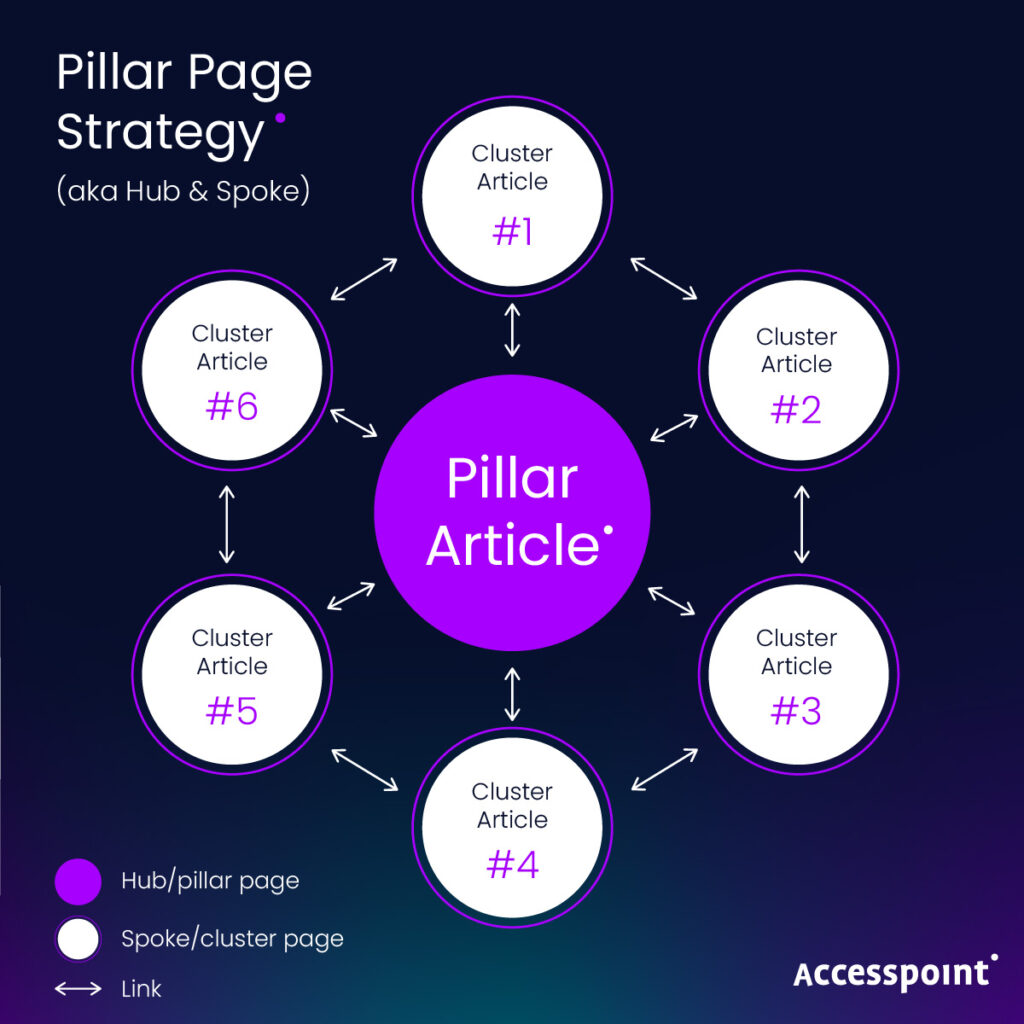Whether you’re a legal professional, small business owner, or marketing manager, understanding and implementing this model can have a transformative impact on your organic traffic.
If you’ve ever found yourself writing multiple blog posts around a given topic but you struggle to see real SEO results, you’re not alone. One of the most effective ways to structure your website content for both users and search engines is the Pillar and Cluster model. It’s a strategic, scalable approach to publishing new content and managing existing content that improves visibility, builds authority, and aligns closely with Google’s emphasis on E-E-A-T – That’s Experience, Expertise, Authoritativeness, and Trustworthiness.
Whether you’re a legal professional, small business owner, or marketing manager, understanding and implementing this model can have a transformative impact on your organic traffic.
Not sure even what SEO is? Check out my recent article where I cover briefly what SEO is, but expand further on how you can write a great blog that gets seen!

What is Pillar and Cluster content?
Think of your website as a book, where each core topic is a chapter and each supporting detail is a sub-section. That’s essentially what Pillar and Cluster content does for SEO.
- Pillar Content is a comprehensive, evergreen page that broadly covers a core topic. It’s usually longer-form, offering an overview of what we might call a parent topic and answers the main questions users might have.
- Cluster Content consists of more focused articles that explore sub-topics in fine detail. Each of these cluster posts links back to the pillar page – and ideally, the pillar links back to them too.
For example:
- Pillar: “The Complete Guide to Separation and Divorce”
- Clusters: “How Divorce Proceedings Work”, “Parental Responsibility Explained”, “Financial Orders After Separation”, etc.
The beauty lies in the internal linking structure. This signals to Google that all this content is thematically connected and well-organised. Like a neatly filed cabinet instead of a messy drawer.


Why is the Pillar and Cluster model so valuable for SEO?
The Pillar and Cluster model isn’t just a tidy way of organising your blog. It offers concrete SEO benefits:
1. Improves topical authority
By covering a topic comprehensively, your site signals to search engines that you’re a subject matter authority – an expert! When Google sees multiple high-quality, interlinked pages around a core topic, it understands that your website is a hub of expertise. The result: it is more likely to rank well for related searches.
2. Boosts keyword rankings
Rather than targeting one keyword per post, this model allows you to target multiple related keywords across different posts, capturing more of the search market. You rank for a wider spread of queries while reinforcing a central topic.
3. Enhances user experience
Users are more likely to stay on your site when they find a clear path through your content. This means better engagement, more pageviews, and lower bounce rates. These are all really positive signals that can support SEO performance.
4. Internal linking benefits
Strategic internal links improve crawlability, distribute link equity, and help users discover related content. This often leads to faster indexing and more meaningful visibility in search results.

How it supports E-E-A-T
E-E-A-T stands for:
- Experience: This refers to first-hand or life experience in the subject matter. Content that reflects direct, lived experience – such as a solicitor describing their role in a complex conveyancing case – is often more insightful and relatable. Google values content that feels authentic and grounded in real-life practice.
- Expertise: This involves the formal knowledge or training behind the content. Are the authors qualified? Do they have the credentials or professional background to speak on the topic? For example, a blog on legal rights authored by a practising solicitor carries significantly more weight than one written by a generalist.
- Authoritativeness: This is about reputation — both of the individual and the website. Has the author or site been referenced or cited by others? Are they recognised within their industry? If your site consistently covers legal topics in-depth and is known for it, that bolsters its authority in the eyes of search engines.
- Trustworthiness: This focuses on whether the site and content can be relied on. Is the content accurate, well-referenced, and transparent about its sources? Trustworthiness also improves when you include things like editorial policies, contact information, and clear authorship.
Google doesn’t explicitly “score” E-E-A-T, but it does reward the kind of content and structure that support it. According to Google’s Search Quality Evaluator Guidelines (2023), high-quality content demonstrates experience, expertise, authoritativeness, and trustworthiness, especially for what Google calls “Your Money or Your Life” topics like legal and health content.
Here’s how Pillar and Cluster content aligns:
Experience
Cluster content gives authors a chance to showcase real-world involvement. For instance, a solicitor might share direct examples from client work, lessons learned from recent case outcomes, or commentary on changes to the law they’ve implemented in practice. This authentic, first-hand perspective helps content stand out – not only in tone but in Google’s eyes too.
Expertise
Expertise stems from formal education, qualifications, and domain knowledge. Through cluster posts, you can cite legislation, explain procedural steps, or debunk myths with professional clarity. By anchoring each of these in a well-researched pillar page, you demonstrate not just occasional insight but structured, consistent subject-matter mastery – a key signal for Google’s ranking systems.
Authoritativeness
Sites that cover topics in breadth and depth, and are structured coherently, signal authority. Think of it from the user’s perspective: who are they more likely to trust — a site with one random article on employment law, or one with a full section, clearly connected, covering every nuance of the topic?
Trustworthiness
The internal structure of pillar and cluster content helps reduce bounce rates and increase engagement – both are great signals to Google of good quality content. When paired with author bios, cited sources, and clear disclosure, this structure builds a genuinely trustworthy user experience.

How do I build a Pillar and Cluster strategy?
Here’s a step-by-step guide for implementing this model. The best part? You don’t need any technical knowledge to get started.
1. Choose a core topic (Pillar)
Start with a subject that’s central to your business and has enough depth to support sub-topics. This could be something rather broad like “Residential Property Law: Buying a property in the UK”.
Your pillar should give a high-level overview of the topic, ideally targeting a high-volume but competitive keyword.
2. Map out supporting Clusters
Use keyword research tools (like SEMrush, Ahrefs, or even Google’s “People also ask”) to identify specific questions or themes within your pillar. Each of these should become its own post:
- “A First-Time Buyers Guide to Buying Your First Home”
- “In-Depth: What are property searches and enquiries when buying a property?”
- “A day in the life of a Conveyancing Solicitor”
3. Interlink thoughtfully
Link from the pillar to the clusters and from clusters back to the pillar. This creates a strong internal linking network that’s easy for search engines and users to follow.
4. Refresh and expand regularly
Google loves fresh, relevant content. As your pillar gains traction, keep adding new clusters to respond to changes in the law, new client queries, or search trends. Plus, remember to revisit your existing content to ensure it’s still relevant and to make small updates that help it remain current.

Final thoughts
The Pillar and Cluster approach is more than a content strategy. It’s a commitment to providing clarity, relevance, and depth in your blogs – the very qualities that align with how Google evaluates and ranks your content. It should empower you to demonstrate your authority on a given topic, strive to meet the needs of the user, and to build and future-proof your SEO strategy.
For non-SEO professionals, this is a real practical way to bring order to your content marketing efforts. And for SEO specialists, it’s a powerful tool to scale performance without sacrificing quality.
If you’re serious about organic growth, then pillar and cluster content isn’t just a nice to have, it’s essential. For more information on why SEO is essential (and why you should give SEO its due attention from day one) then check out my recent article: SEO not SOS.
 Rich Holgate
Rich Holgate